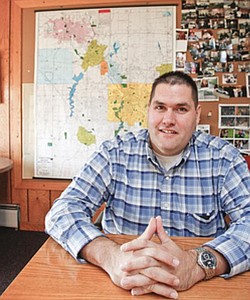New chief wants patrons to feel safe
PARK CHIEF: Jim Willock was named chief of the Mill Creek MetroParks police last month after having served the same position for the Goshen police. He explained the difference and similarities between traditional police work and the responsibilities of the park police.
By Jon Moffett
The police department often acts as a public- relations staff.
YOUNGSTOWN — Jim Willock chuckles to himself when he thinks about the similarities and differences in his current and former jobs.
Once the chief of the Goshen Police Department, Willock now has the same role with the Mill Creek MetroParks police force.
“I went from cows to squirrels,” he said jokingly.
Willock was named chief last month and is still learning the nuances of the job. But Willock would acknowledge that the biggest difference between traditional police work and that of a metropolitan park police officer is in the job description.
“We’re very diversified,” said patrolman Wilbur Drayton, who is in his 16th year as a MetroParks police officer. “There’s no one thing we do. We do a little bit of everything.”
Willock said much of the job is acting almost like a public- relations staff for the park. He said the officers represent the park but also act as liaisons to its patrons.
Patrolman Christian Hunter, who has worked for park police part time since 2002, said a portion of the job is about building relationships with the public.
“Part of my job is to establish a good rapport with the patrons,” he said. “Sometimes I ask them more questions than they ask me.”
But there is much more to being a MetroParks police officer than squirrels and public relations.
The primary responsibility of the police force is like any other, Willock said.
“One of the biggest things in law enforcement, wherever you are, is feeling,” he said. “People have to feel safe in their environment.”
Drayton added, “You try to make people feel like they’re at home.”
Crime in the park can range from hunting to loitering, vandalism or dumping. One officer has the duty of “property lines,” which consists of the officer’s walking the perimeter of the park to ensure the adjacent properties aren’t dumping leaves or garbage into the park.
There are 4,400 acres of MetroParks, of which 2,882 is Mill Creek Park itself.
Other officers patrol the trails, roads, picnic areas and other venues within the park and its properties.
And though the differences between the MetroParks and other police departments are clear, the similarities are equally clear.
“Sometimes you have to be the bad guy; it’s your job,” Hunter said. “But I would say more often you’re the good guy in the public’s eye.”
Willock said the majority of the police work done is the form of backing up other agencies or working as security detail for public or private parties in the park.
Willock added that many people “respect the park,” and not much criminal activity happens on the property.
Robert Thomas, one of three park rangers who work exclusively at Fellows Riverside Gardens, said other park departments and the police “depend on each other” to co-exist.
“We’re like the public relations side, or the ambassadors to the park,” Thomas said. “We try to make people feel as comfortable as possible.”
The No. 1 goal for the police department, though, is to ensure a safe and enjoyable visit. Officers encourage patrons to stop, say hello and have a chat about any questions they might have.
“It’s not always about locking up the bad guys,” Drayton said. “It’s about public service.”
 43
43

